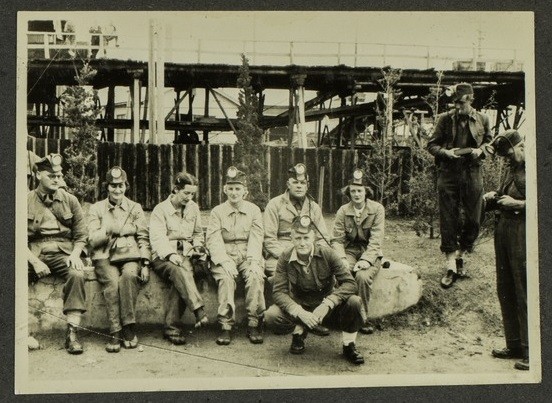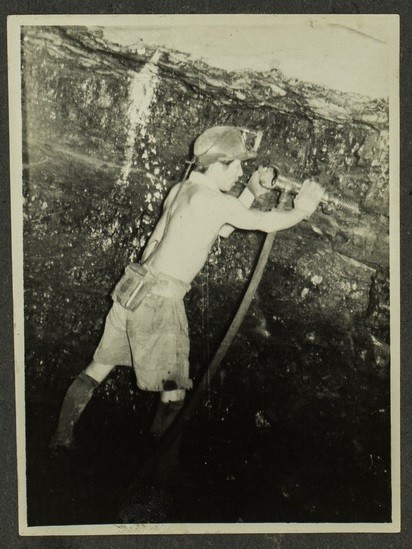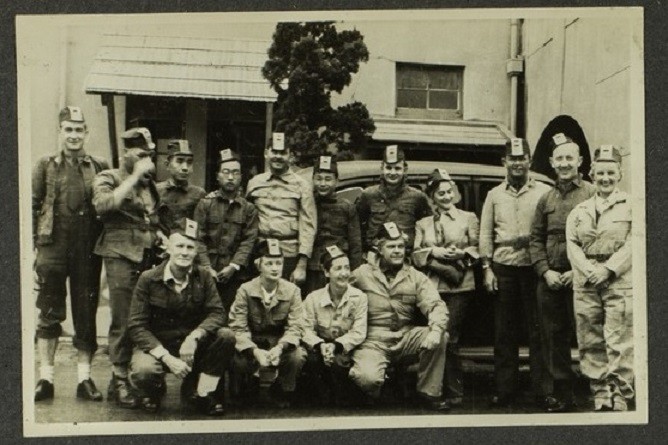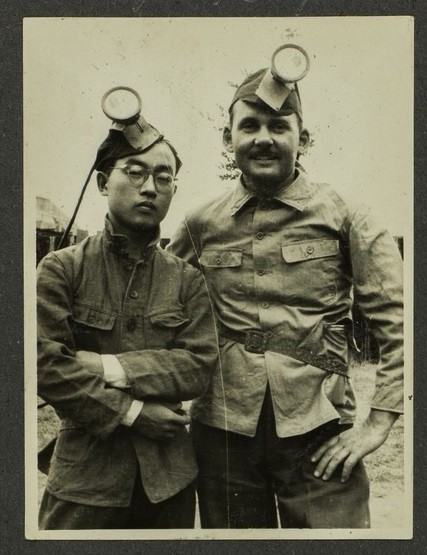Okinoyama – The Story of a Coal Mine
By Greg Corbett, Visitor Services Assistant, Anzac Square Memorial Galleries | 6 January 2023

Photo from the Clement Neville Govett Papers labelled, 'Aki No Yama coal mine inspection, Ube, southern Honshu, Japan, November 1949’
Enter the Post World War II Gallery at Anzac Square Memorial Galleries and you’ll see a series of large interactive screens. On one of the screens, you’ll find a world map, allowing you to click on various countries to explore Australia’s military involvement overseas. Click on Japan and you can view the above photo from the Clement Neville Govett papers in the State Library collection.
The photo is labelled, ‘Aki No Yama coal mine inspection, Ube, southern Honshu, Japan, November 1949’. Coal was mined at Ube (Yamaguchi Prefecture) from as far back as the late 17th Century, with its mining industry experiencing significant growth in the mid 19th century. The above photo no doubt refers to 'Okinoyama’, an Ube coal mine.

Govett, Clement Neville. Clement Neville Govett Papers 1950-1951. N.p., 1950. Print.
During World War II, Ube was also the location of the Okinoyama Prisoner of War Camp. Reports vary, but it appears some 280 prisoners were held at the camp at war’s end. They were made to work in the mines in what were evidently difficult and dangerous conditions, and there are numerous accounts that each person had to reach a quota of 1.5 tons of coal per day. 20 POWs died at the camp.
From 1946 to 1952, joint Australian, British, Indian and New Zealand military forces (known as the British Commonwealth Occupation Force) were given the task of occupying five prefectures of Japan (as well as Shikoku Island), including Yamaguchi Prefecture. They were tasked with demilitarisation and disposal of Japan’s remaining war-making capacity.

Govett, Clement Neville. Clement Neville Govett Papers 1950-1951. N.p., 1950. Print.
Clement Neville Govett was sergeant of a transport platoon in the BCOF, and his collection contains some additional photos of the coal mine inspection mentioned above. The exact circumstances and purpose of the visit are unclear, but it’s worth noting orders issued by the Supreme Commander for the Allied Powers that may give some indication of BCOF’s interest in the mine.
Firstly, Japan was required to foot the bill for costs of the occupation, and this included the provision of commodities such as coal. Coal shortages were an ongoing issue during the occupation, and in March 1949, the headquarters of General Douglas MacArthur issued a series of wide-ranging instructions to the Japanese Government to improve the efficiency and production capacity of the nation’s coal mining industry.

Govett, Clement Neville. Clement Neville Govett Papers 1950-1951. N.p., 1950. Print.
Incidentally, coal production spurred Ube’s economic recovery, but the city subsequently encountered pollution issues while generating energy from coal. The process used created large quantities of ash that fell on the city, with citizens reportedly not being able to hang their clothes outside or even open their windows. What’s interesting is that the city was able to turn things around through a consultative process between industry, government, academia and private citizens to implement effective pollution control measures. This led to Ube City being awarded the Global 500 Award of the United Nations Environment Programme (UNEP) in 1997 for its environmental initiatives.
The Post World War II Gallery at Anzac Square Memorial Galleries
Anzac Square Memorial Galleries is open 10am-4pm Sunday - Friday and entry is free. You can also view the Clement Neville Govett Papers online at State Library of Queensland.
References
Australian War Memorial 2021, ‘British Commonwealth Occupation Force 1945–52’, 2 June 2021, viewed 21 October 2021, <https://www.awm.gov.au/articles/atwar/bcof>
Braisher, M 2018, 'Life in a Japanese Prisoner of War Camp', Adam Matthew, 27 April 2018, viewed 23 October 2021, <https://www.amdigital.co.uk/about/blog/item/life-in-a-japanese-prisoner-of-war-camp>
Britannica n.d., ‘Ube Japan’, Britannica.com, viewed 21 October 2021, <https://www.britannica.com/place/Ube>
Fukubayashi, T n.d., ‘POW Camps in Japan Proper’, POW Research Network Japan, viewed 21 October 2021, <http://www.powresearch.jp/en/archive/camplist/index.html>
Govett, C N 1951, ‘OM74-70 Clement Neville Govett Papers 1950-1951 (1950)’
Roehner, B 2008, ‘Occupation of Japan’, hal-01708196, viewed 21 October 2021, <https://hal.sorbonne-universite.fr/hal-01708196/document>
Tsunoda, I 2007, 'The 'Ube Method' of Environmental Policy: From Local Beginnings (Ube City, Yamaguchi Prefecture) to the World', Japan for Sustainability, 31 May 2007, viewed 23 October 2021, <https://www.japanfs.org/en/news/archives/news_id027946.html>
Comments
Your email address will not be published.
We welcome relevant, respectful comments.